Exploring Complexities: Implementing Inclusion Policy in Practice
VerifiedAdded on 2023/06/13
|13
|4555
|257
Essay
AI Summary
This essay provides a critical analysis of the complexities faced by professionals in the field of inclusion, particularly in translating policy into practice. It highlights the challenges related to ensuring equal opportunities and respect for all children, addressing mental health issues, and promoting social justice. The essay also examines two articles: one focusing on challenges and opportunities in inclusive education in India, emphasizing the need for appropriate professional development and resources, and the other discussing the dilemma of inclusive education, questioning whether it is truly for all or just for some. The analysis underscores the importance of addressing barriers to education, involving parents, and fostering a culture of belonging, while also acknowledging the difficulties professionals face in dealing with diverse student needs and the impact on their own mental health. Desklib provides access to this and other solved assignments for students.
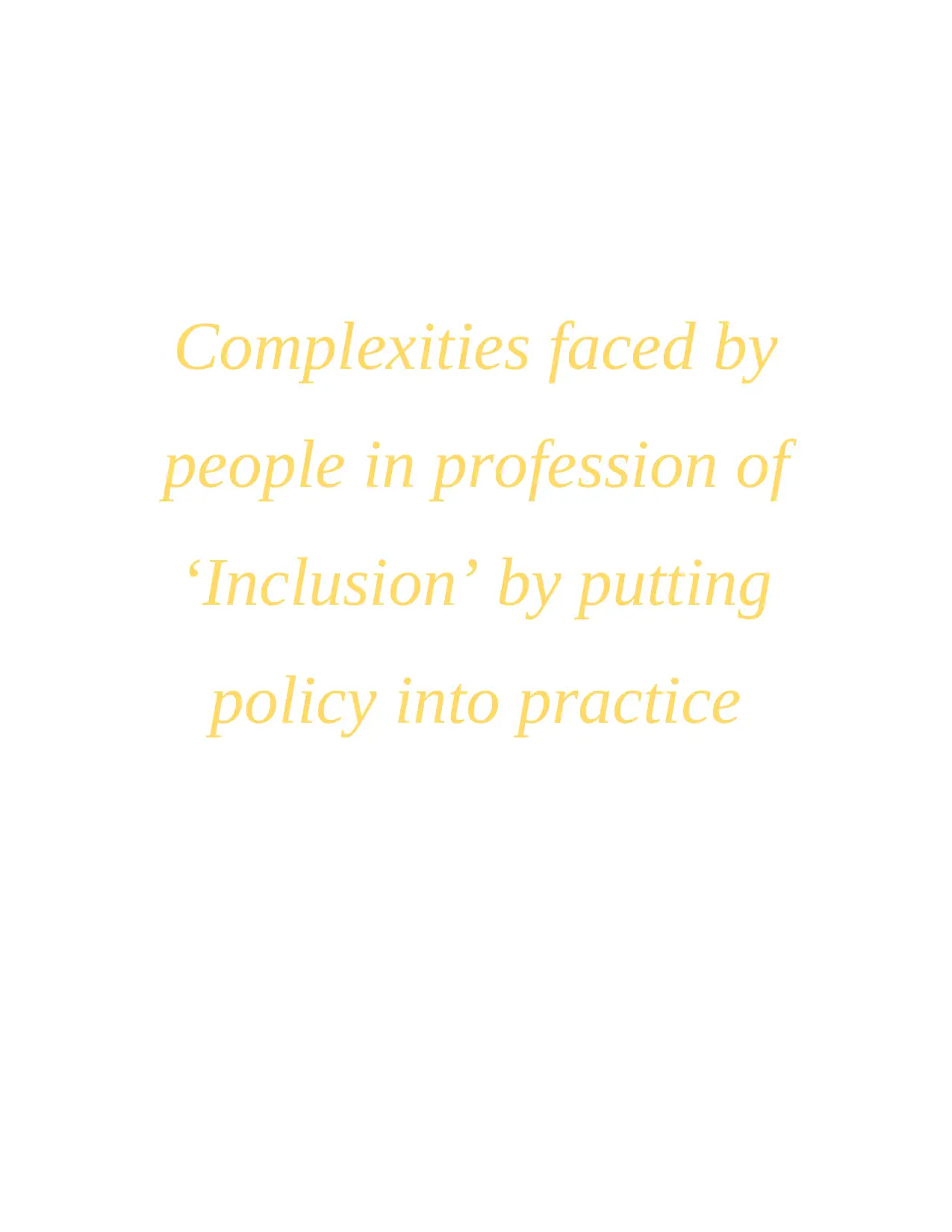
Complexities faced by
people in profession of
‘Inclusion’ by putting
policy into practice
people in profession of
‘Inclusion’ by putting
policy into practice
Paraphrase This Document
Need a fresh take? Get an instant paraphrase of this document with our AI Paraphraser
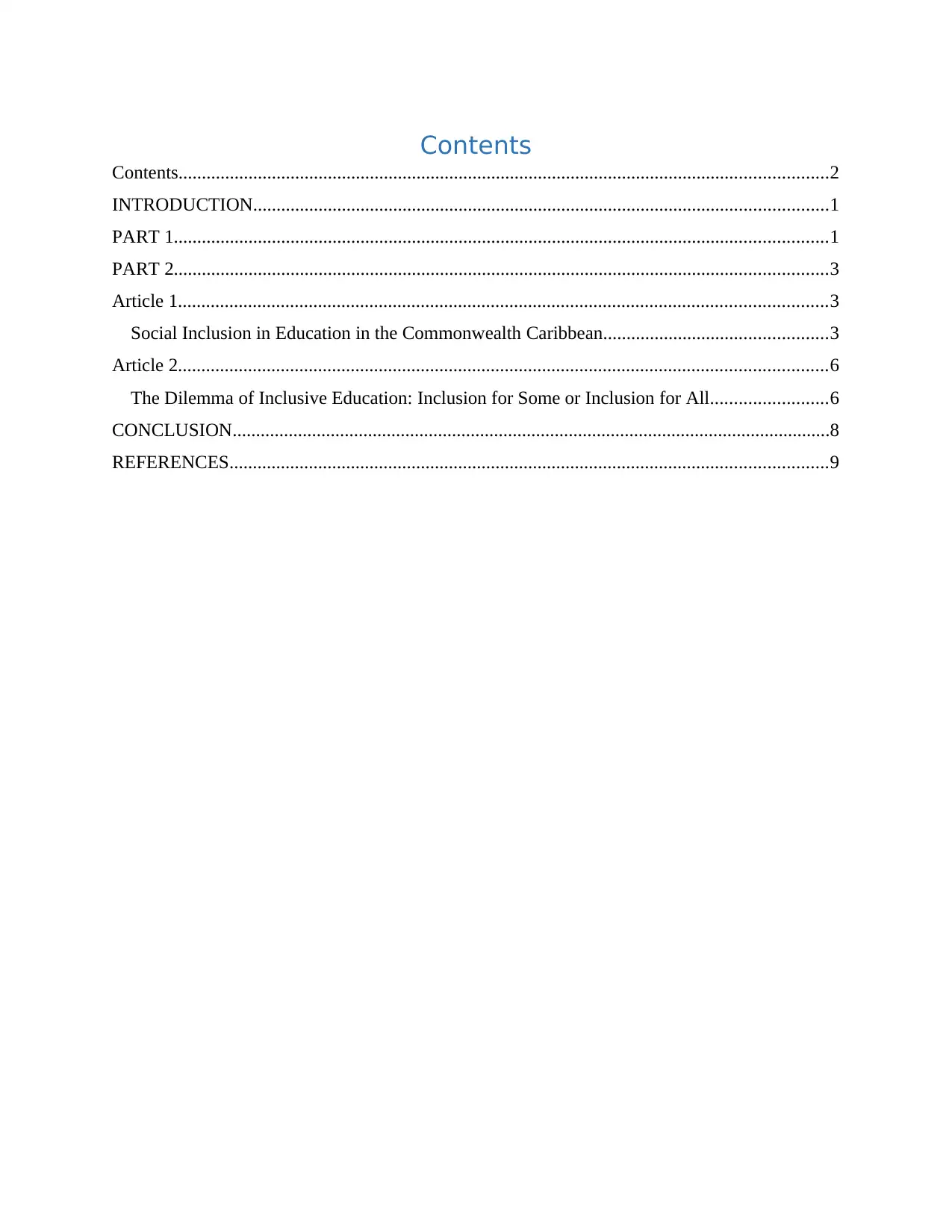
Contents
Contents...........................................................................................................................................2
INTRODUCTION...........................................................................................................................1
PART 1............................................................................................................................................1
PART 2............................................................................................................................................3
Article 1...........................................................................................................................................3
Social Inclusion in Education in the Commonwealth Caribbean................................................3
Article 2...........................................................................................................................................6
The Dilemma of Inclusive Education: Inclusion for Some or Inclusion for All.........................6
CONCLUSION................................................................................................................................8
REFERENCES................................................................................................................................9
Contents...........................................................................................................................................2
INTRODUCTION...........................................................................................................................1
PART 1............................................................................................................................................1
PART 2............................................................................................................................................3
Article 1...........................................................................................................................................3
Social Inclusion in Education in the Commonwealth Caribbean................................................3
Article 2...........................................................................................................................................6
The Dilemma of Inclusive Education: Inclusion for Some or Inclusion for All.........................6
CONCLUSION................................................................................................................................8
REFERENCES................................................................................................................................9

⊘ This is a preview!⊘
Do you want full access?
Subscribe today to unlock all pages.

Trusted by 1+ million students worldwide
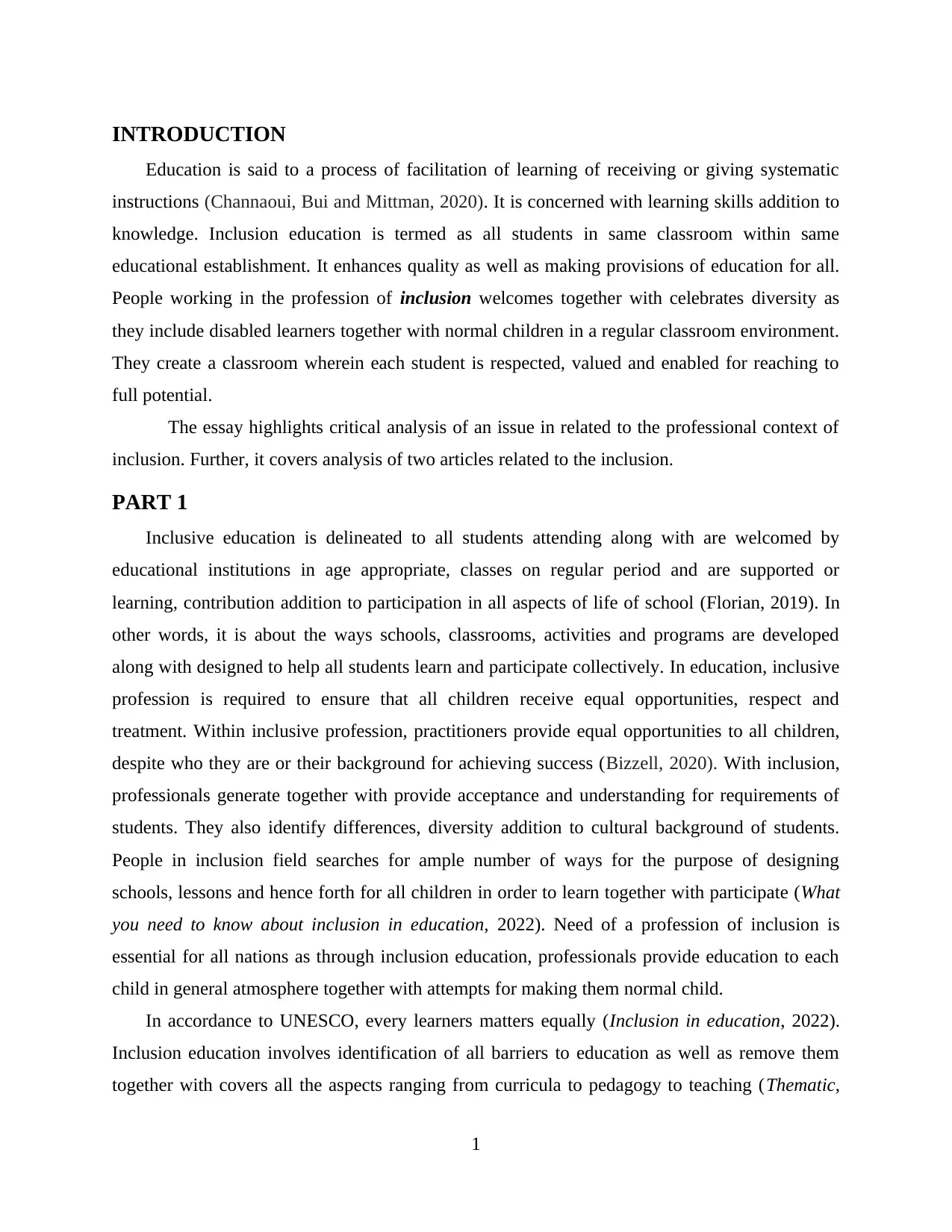
INTRODUCTION
Education is said to a process of facilitation of learning of receiving or giving systematic
instructions (Channaoui, Bui and Mittman, 2020). It is concerned with learning skills addition to
knowledge. Inclusion education is termed as all students in same classroom within same
educational establishment. It enhances quality as well as making provisions of education for all.
People working in the profession of inclusion welcomes together with celebrates diversity as
they include disabled learners together with normal children in a regular classroom environment.
They create a classroom wherein each student is respected, valued and enabled for reaching to
full potential.
The essay highlights critical analysis of an issue in related to the professional context of
inclusion. Further, it covers analysis of two articles related to the inclusion.
PART 1
Inclusive education is delineated to all students attending along with are welcomed by
educational institutions in age appropriate, classes on regular period and are supported or
learning, contribution addition to participation in all aspects of life of school (Florian, 2019). In
other words, it is about the ways schools, classrooms, activities and programs are developed
along with designed to help all students learn and participate collectively. In education, inclusive
profession is required to ensure that all children receive equal opportunities, respect and
treatment. Within inclusive profession, practitioners provide equal opportunities to all children,
despite who they are or their background for achieving success (Bizzell, 2020). With inclusion,
professionals generate together with provide acceptance and understanding for requirements of
students. They also identify differences, diversity addition to cultural background of students.
People in inclusion field searches for ample number of ways for the purpose of designing
schools, lessons and hence forth for all children in order to learn together with participate (What
you need to know about inclusion in education, 2022). Need of a profession of inclusion is
essential for all nations as through inclusion education, professionals provide education to each
child in general atmosphere together with attempts for making them normal child.
In accordance to UNESCO, every learners matters equally (Inclusion in education, 2022).
Inclusion education involves identification of all barriers to education as well as remove them
together with covers all the aspects ranging from curricula to pedagogy to teaching (Thematic,
1
Education is said to a process of facilitation of learning of receiving or giving systematic
instructions (Channaoui, Bui and Mittman, 2020). It is concerned with learning skills addition to
knowledge. Inclusion education is termed as all students in same classroom within same
educational establishment. It enhances quality as well as making provisions of education for all.
People working in the profession of inclusion welcomes together with celebrates diversity as
they include disabled learners together with normal children in a regular classroom environment.
They create a classroom wherein each student is respected, valued and enabled for reaching to
full potential.
The essay highlights critical analysis of an issue in related to the professional context of
inclusion. Further, it covers analysis of two articles related to the inclusion.
PART 1
Inclusive education is delineated to all students attending along with are welcomed by
educational institutions in age appropriate, classes on regular period and are supported or
learning, contribution addition to participation in all aspects of life of school (Florian, 2019). In
other words, it is about the ways schools, classrooms, activities and programs are developed
along with designed to help all students learn and participate collectively. In education, inclusive
profession is required to ensure that all children receive equal opportunities, respect and
treatment. Within inclusive profession, practitioners provide equal opportunities to all children,
despite who they are or their background for achieving success (Bizzell, 2020). With inclusion,
professionals generate together with provide acceptance and understanding for requirements of
students. They also identify differences, diversity addition to cultural background of students.
People in inclusion field searches for ample number of ways for the purpose of designing
schools, lessons and hence forth for all children in order to learn together with participate (What
you need to know about inclusion in education, 2022). Need of a profession of inclusion is
essential for all nations as through inclusion education, professionals provide education to each
child in general atmosphere together with attempts for making them normal child.
In accordance to UNESCO, every learners matters equally (Inclusion in education, 2022).
Inclusion education involves identification of all barriers to education as well as remove them
together with covers all the aspects ranging from curricula to pedagogy to teaching (Thematic,
1
Paraphrase This Document
Need a fresh take? Get an instant paraphrase of this document with our AI Paraphraser
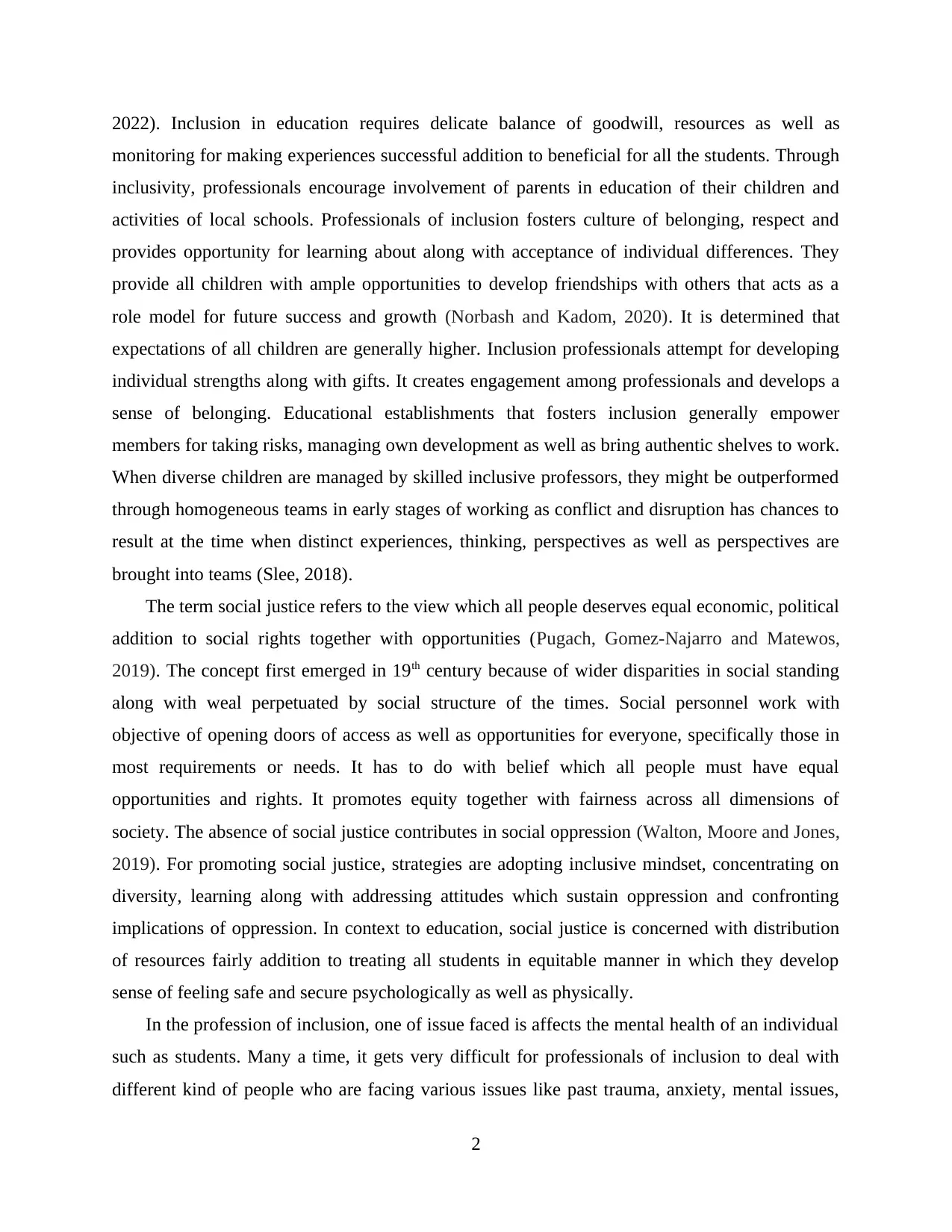
2022). Inclusion in education requires delicate balance of goodwill, resources as well as
monitoring for making experiences successful addition to beneficial for all the students. Through
inclusivity, professionals encourage involvement of parents in education of their children and
activities of local schools. Professionals of inclusion fosters culture of belonging, respect and
provides opportunity for learning about along with acceptance of individual differences. They
provide all children with ample opportunities to develop friendships with others that acts as a
role model for future success and growth (Norbash and Kadom, 2020). It is determined that
expectations of all children are generally higher. Inclusion professionals attempt for developing
individual strengths along with gifts. It creates engagement among professionals and develops a
sense of belonging. Educational establishments that fosters inclusion generally empower
members for taking risks, managing own development as well as bring authentic shelves to work.
When diverse children are managed by skilled inclusive professors, they might be outperformed
through homogeneous teams in early stages of working as conflict and disruption has chances to
result at the time when distinct experiences, thinking, perspectives as well as perspectives are
brought into teams (Slee, 2018).
The term social justice refers to the view which all people deserves equal economic, political
addition to social rights together with opportunities (Pugach, Gomez-Najarro and Matewos,
2019). The concept first emerged in 19th century because of wider disparities in social standing
along with weal perpetuated by social structure of the times. Social personnel work with
objective of opening doors of access as well as opportunities for everyone, specifically those in
most requirements or needs. It has to do with belief which all people must have equal
opportunities and rights. It promotes equity together with fairness across all dimensions of
society. The absence of social justice contributes in social oppression (Walton, Moore and Jones,
2019). For promoting social justice, strategies are adopting inclusive mindset, concentrating on
diversity, learning along with addressing attitudes which sustain oppression and confronting
implications of oppression. In context to education, social justice is concerned with distribution
of resources fairly addition to treating all students in equitable manner in which they develop
sense of feeling safe and secure psychologically as well as physically.
In the profession of inclusion, one of issue faced is affects the mental health of an individual
such as students. Many a time, it gets very difficult for professionals of inclusion to deal with
different kind of people who are facing various issues like past trauma, anxiety, mental issues,
2
monitoring for making experiences successful addition to beneficial for all the students. Through
inclusivity, professionals encourage involvement of parents in education of their children and
activities of local schools. Professionals of inclusion fosters culture of belonging, respect and
provides opportunity for learning about along with acceptance of individual differences. They
provide all children with ample opportunities to develop friendships with others that acts as a
role model for future success and growth (Norbash and Kadom, 2020). It is determined that
expectations of all children are generally higher. Inclusion professionals attempt for developing
individual strengths along with gifts. It creates engagement among professionals and develops a
sense of belonging. Educational establishments that fosters inclusion generally empower
members for taking risks, managing own development as well as bring authentic shelves to work.
When diverse children are managed by skilled inclusive professors, they might be outperformed
through homogeneous teams in early stages of working as conflict and disruption has chances to
result at the time when distinct experiences, thinking, perspectives as well as perspectives are
brought into teams (Slee, 2018).
The term social justice refers to the view which all people deserves equal economic, political
addition to social rights together with opportunities (Pugach, Gomez-Najarro and Matewos,
2019). The concept first emerged in 19th century because of wider disparities in social standing
along with weal perpetuated by social structure of the times. Social personnel work with
objective of opening doors of access as well as opportunities for everyone, specifically those in
most requirements or needs. It has to do with belief which all people must have equal
opportunities and rights. It promotes equity together with fairness across all dimensions of
society. The absence of social justice contributes in social oppression (Walton, Moore and Jones,
2019). For promoting social justice, strategies are adopting inclusive mindset, concentrating on
diversity, learning along with addressing attitudes which sustain oppression and confronting
implications of oppression. In context to education, social justice is concerned with distribution
of resources fairly addition to treating all students in equitable manner in which they develop
sense of feeling safe and secure psychologically as well as physically.
In the profession of inclusion, one of issue faced is affects the mental health of an individual
such as students. Many a time, it gets very difficult for professionals of inclusion to deal with
different kind of people who are facing various issues like past trauma, anxiety, mental issues,
2
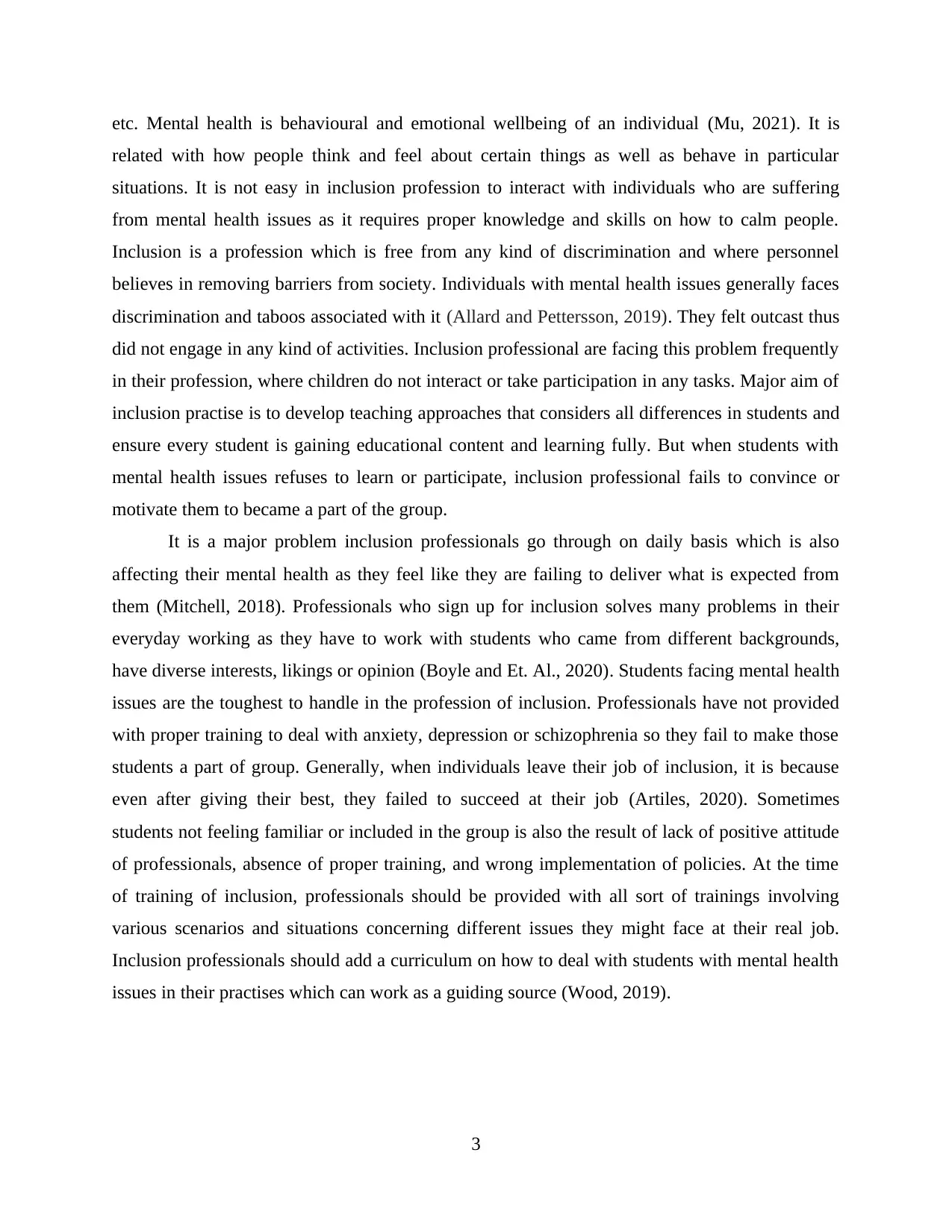
etc. Mental health is behavioural and emotional wellbeing of an individual (Mu, 2021). It is
related with how people think and feel about certain things as well as behave in particular
situations. It is not easy in inclusion profession to interact with individuals who are suffering
from mental health issues as it requires proper knowledge and skills on how to calm people.
Inclusion is a profession which is free from any kind of discrimination and where personnel
believes in removing barriers from society. Individuals with mental health issues generally faces
discrimination and taboos associated with it (Allard and Pettersson, 2019). They felt outcast thus
did not engage in any kind of activities. Inclusion professional are facing this problem frequently
in their profession, where children do not interact or take participation in any tasks. Major aim of
inclusion practise is to develop teaching approaches that considers all differences in students and
ensure every student is gaining educational content and learning fully. But when students with
mental health issues refuses to learn or participate, inclusion professional fails to convince or
motivate them to became a part of the group.
It is a major problem inclusion professionals go through on daily basis which is also
affecting their mental health as they feel like they are failing to deliver what is expected from
them (Mitchell, 2018). Professionals who sign up for inclusion solves many problems in their
everyday working as they have to work with students who came from different backgrounds,
have diverse interests, likings or opinion (Boyle and Et. Al., 2020). Students facing mental health
issues are the toughest to handle in the profession of inclusion. Professionals have not provided
with proper training to deal with anxiety, depression or schizophrenia so they fail to make those
students a part of group. Generally, when individuals leave their job of inclusion, it is because
even after giving their best, they failed to succeed at their job (Artiles, 2020). Sometimes
students not feeling familiar or included in the group is also the result of lack of positive attitude
of professionals, absence of proper training, and wrong implementation of policies. At the time
of training of inclusion, professionals should be provided with all sort of trainings involving
various scenarios and situations concerning different issues they might face at their real job.
Inclusion professionals should add a curriculum on how to deal with students with mental health
issues in their practises which can work as a guiding source (Wood, 2019).
3
related with how people think and feel about certain things as well as behave in particular
situations. It is not easy in inclusion profession to interact with individuals who are suffering
from mental health issues as it requires proper knowledge and skills on how to calm people.
Inclusion is a profession which is free from any kind of discrimination and where personnel
believes in removing barriers from society. Individuals with mental health issues generally faces
discrimination and taboos associated with it (Allard and Pettersson, 2019). They felt outcast thus
did not engage in any kind of activities. Inclusion professional are facing this problem frequently
in their profession, where children do not interact or take participation in any tasks. Major aim of
inclusion practise is to develop teaching approaches that considers all differences in students and
ensure every student is gaining educational content and learning fully. But when students with
mental health issues refuses to learn or participate, inclusion professional fails to convince or
motivate them to became a part of the group.
It is a major problem inclusion professionals go through on daily basis which is also
affecting their mental health as they feel like they are failing to deliver what is expected from
them (Mitchell, 2018). Professionals who sign up for inclusion solves many problems in their
everyday working as they have to work with students who came from different backgrounds,
have diverse interests, likings or opinion (Boyle and Et. Al., 2020). Students facing mental health
issues are the toughest to handle in the profession of inclusion. Professionals have not provided
with proper training to deal with anxiety, depression or schizophrenia so they fail to make those
students a part of group. Generally, when individuals leave their job of inclusion, it is because
even after giving their best, they failed to succeed at their job (Artiles, 2020). Sometimes
students not feeling familiar or included in the group is also the result of lack of positive attitude
of professionals, absence of proper training, and wrong implementation of policies. At the time
of training of inclusion, professionals should be provided with all sort of trainings involving
various scenarios and situations concerning different issues they might face at their real job.
Inclusion professionals should add a curriculum on how to deal with students with mental health
issues in their practises which can work as a guiding source (Wood, 2019).
3
⊘ This is a preview!⊘
Do you want full access?
Subscribe today to unlock all pages.

Trusted by 1+ million students worldwide
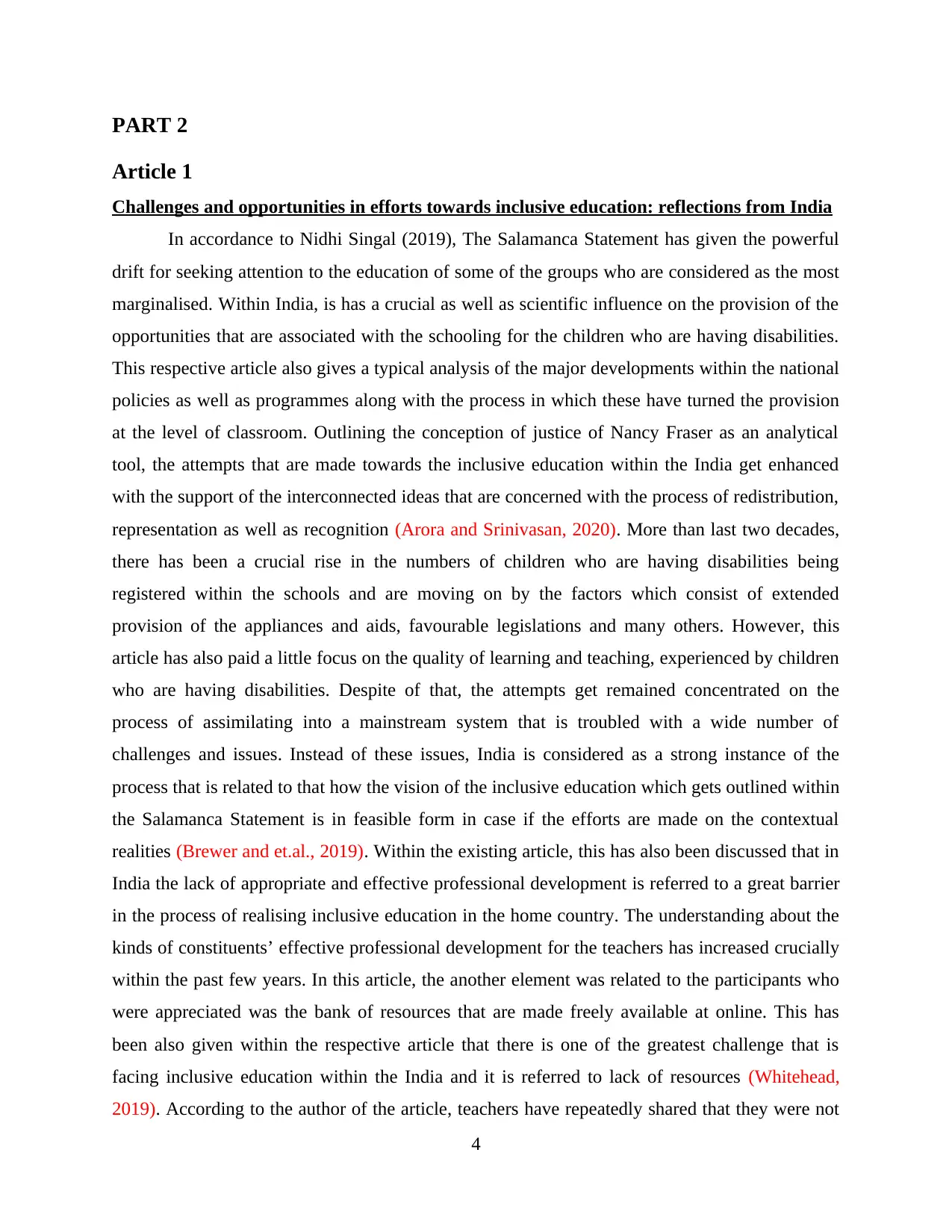
PART 2
Article 1
Challenges and opportunities in efforts towards inclusive education: reflections from India
In accordance to Nidhi Singal (2019), The Salamanca Statement has given the powerful
drift for seeking attention to the education of some of the groups who are considered as the most
marginalised. Within India, is has a crucial as well as scientific influence on the provision of the
opportunities that are associated with the schooling for the children who are having disabilities.
This respective article also gives a typical analysis of the major developments within the national
policies as well as programmes along with the process in which these have turned the provision
at the level of classroom. Outlining the conception of justice of Nancy Fraser as an analytical
tool, the attempts that are made towards the inclusive education within the India get enhanced
with the support of the interconnected ideas that are concerned with the process of redistribution,
representation as well as recognition (Arora and Srinivasan, 2020). More than last two decades,
there has been a crucial rise in the numbers of children who are having disabilities being
registered within the schools and are moving on by the factors which consist of extended
provision of the appliances and aids, favourable legislations and many others. However, this
article has also paid a little focus on the quality of learning and teaching, experienced by children
who are having disabilities. Despite of that, the attempts get remained concentrated on the
process of assimilating into a mainstream system that is troubled with a wide number of
challenges and issues. Instead of these issues, India is considered as a strong instance of the
process that is related to that how the vision of the inclusive education which gets outlined within
the Salamanca Statement is in feasible form in case if the efforts are made on the contextual
realities (Brewer and et.al., 2019). Within the existing article, this has also been discussed that in
India the lack of appropriate and effective professional development is referred to a great barrier
in the process of realising inclusive education in the home country. The understanding about the
kinds of constituents’ effective professional development for the teachers has increased crucially
within the past few years. In this article, the another element was related to the participants who
were appreciated was the bank of resources that are made freely available at online. This has
been also given within the respective article that there is one of the greatest challenge that is
facing inclusive education within the India and it is referred to lack of resources (Whitehead,
2019). According to the author of the article, teachers have repeatedly shared that they were not
4
Article 1
Challenges and opportunities in efforts towards inclusive education: reflections from India
In accordance to Nidhi Singal (2019), The Salamanca Statement has given the powerful
drift for seeking attention to the education of some of the groups who are considered as the most
marginalised. Within India, is has a crucial as well as scientific influence on the provision of the
opportunities that are associated with the schooling for the children who are having disabilities.
This respective article also gives a typical analysis of the major developments within the national
policies as well as programmes along with the process in which these have turned the provision
at the level of classroom. Outlining the conception of justice of Nancy Fraser as an analytical
tool, the attempts that are made towards the inclusive education within the India get enhanced
with the support of the interconnected ideas that are concerned with the process of redistribution,
representation as well as recognition (Arora and Srinivasan, 2020). More than last two decades,
there has been a crucial rise in the numbers of children who are having disabilities being
registered within the schools and are moving on by the factors which consist of extended
provision of the appliances and aids, favourable legislations and many others. However, this
article has also paid a little focus on the quality of learning and teaching, experienced by children
who are having disabilities. Despite of that, the attempts get remained concentrated on the
process of assimilating into a mainstream system that is troubled with a wide number of
challenges and issues. Instead of these issues, India is considered as a strong instance of the
process that is related to that how the vision of the inclusive education which gets outlined within
the Salamanca Statement is in feasible form in case if the efforts are made on the contextual
realities (Brewer and et.al., 2019). Within the existing article, this has also been discussed that in
India the lack of appropriate and effective professional development is referred to a great barrier
in the process of realising inclusive education in the home country. The understanding about the
kinds of constituents’ effective professional development for the teachers has increased crucially
within the past few years. In this article, the another element was related to the participants who
were appreciated was the bank of resources that are made freely available at online. This has
been also given within the respective article that there is one of the greatest challenge that is
facing inclusive education within the India and it is referred to lack of resources (Whitehead,
2019). According to the author of the article, teachers have repeatedly shared that they were not
4
Paraphrase This Document
Need a fresh take? Get an instant paraphrase of this document with our AI Paraphraser
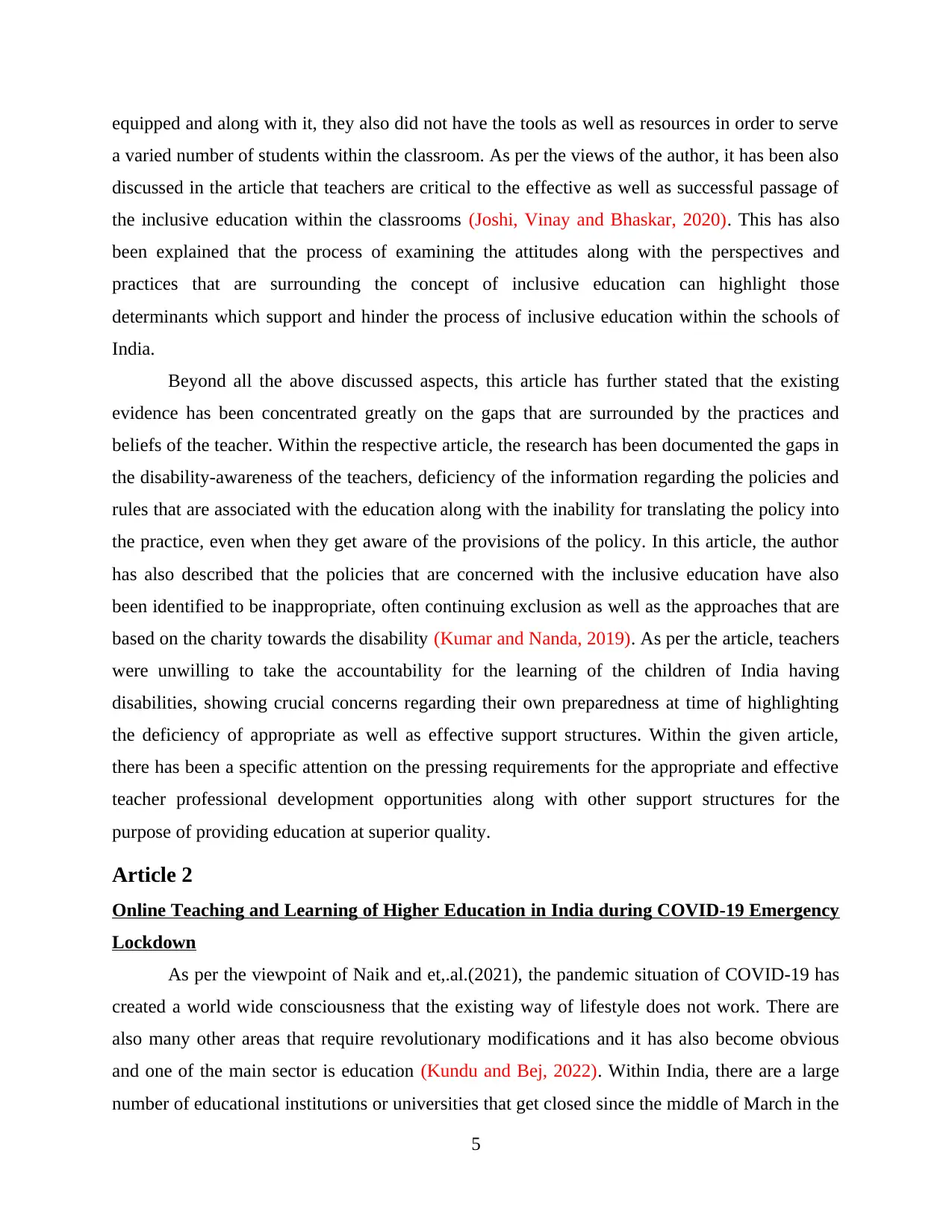
equipped and along with it, they also did not have the tools as well as resources in order to serve
a varied number of students within the classroom. As per the views of the author, it has been also
discussed in the article that teachers are critical to the effective as well as successful passage of
the inclusive education within the classrooms (Joshi, Vinay and Bhaskar, 2020). This has also
been explained that the process of examining the attitudes along with the perspectives and
practices that are surrounding the concept of inclusive education can highlight those
determinants which support and hinder the process of inclusive education within the schools of
India.
Beyond all the above discussed aspects, this article has further stated that the existing
evidence has been concentrated greatly on the gaps that are surrounded by the practices and
beliefs of the teacher. Within the respective article, the research has been documented the gaps in
the disability-awareness of the teachers, deficiency of the information regarding the policies and
rules that are associated with the education along with the inability for translating the policy into
the practice, even when they get aware of the provisions of the policy. In this article, the author
has also described that the policies that are concerned with the inclusive education have also
been identified to be inappropriate, often continuing exclusion as well as the approaches that are
based on the charity towards the disability (Kumar and Nanda, 2019). As per the article, teachers
were unwilling to take the accountability for the learning of the children of India having
disabilities, showing crucial concerns regarding their own preparedness at time of highlighting
the deficiency of appropriate as well as effective support structures. Within the given article,
there has been a specific attention on the pressing requirements for the appropriate and effective
teacher professional development opportunities along with other support structures for the
purpose of providing education at superior quality.
Article 2
Online Teaching and Learning of Higher Education in India during COVID-19 Emergency
Lockdown
As per the viewpoint of Naik and et,.al.(2021), the pandemic situation of COVID-19 has
created a world wide consciousness that the existing way of lifestyle does not work. There are
also many other areas that require revolutionary modifications and it has also become obvious
and one of the main sector is education (Kundu and Bej, 2022). Within India, there are a large
number of educational institutions or universities that get closed since the middle of March in the
5
a varied number of students within the classroom. As per the views of the author, it has been also
discussed in the article that teachers are critical to the effective as well as successful passage of
the inclusive education within the classrooms (Joshi, Vinay and Bhaskar, 2020). This has also
been explained that the process of examining the attitudes along with the perspectives and
practices that are surrounding the concept of inclusive education can highlight those
determinants which support and hinder the process of inclusive education within the schools of
India.
Beyond all the above discussed aspects, this article has further stated that the existing
evidence has been concentrated greatly on the gaps that are surrounded by the practices and
beliefs of the teacher. Within the respective article, the research has been documented the gaps in
the disability-awareness of the teachers, deficiency of the information regarding the policies and
rules that are associated with the education along with the inability for translating the policy into
the practice, even when they get aware of the provisions of the policy. In this article, the author
has also described that the policies that are concerned with the inclusive education have also
been identified to be inappropriate, often continuing exclusion as well as the approaches that are
based on the charity towards the disability (Kumar and Nanda, 2019). As per the article, teachers
were unwilling to take the accountability for the learning of the children of India having
disabilities, showing crucial concerns regarding their own preparedness at time of highlighting
the deficiency of appropriate as well as effective support structures. Within the given article,
there has been a specific attention on the pressing requirements for the appropriate and effective
teacher professional development opportunities along with other support structures for the
purpose of providing education at superior quality.
Article 2
Online Teaching and Learning of Higher Education in India during COVID-19 Emergency
Lockdown
As per the viewpoint of Naik and et,.al.(2021), the pandemic situation of COVID-19 has
created a world wide consciousness that the existing way of lifestyle does not work. There are
also many other areas that require revolutionary modifications and it has also become obvious
and one of the main sector is education (Kundu and Bej, 2022). Within India, there are a large
number of educational institutions or universities that get closed since the middle of March in the
5
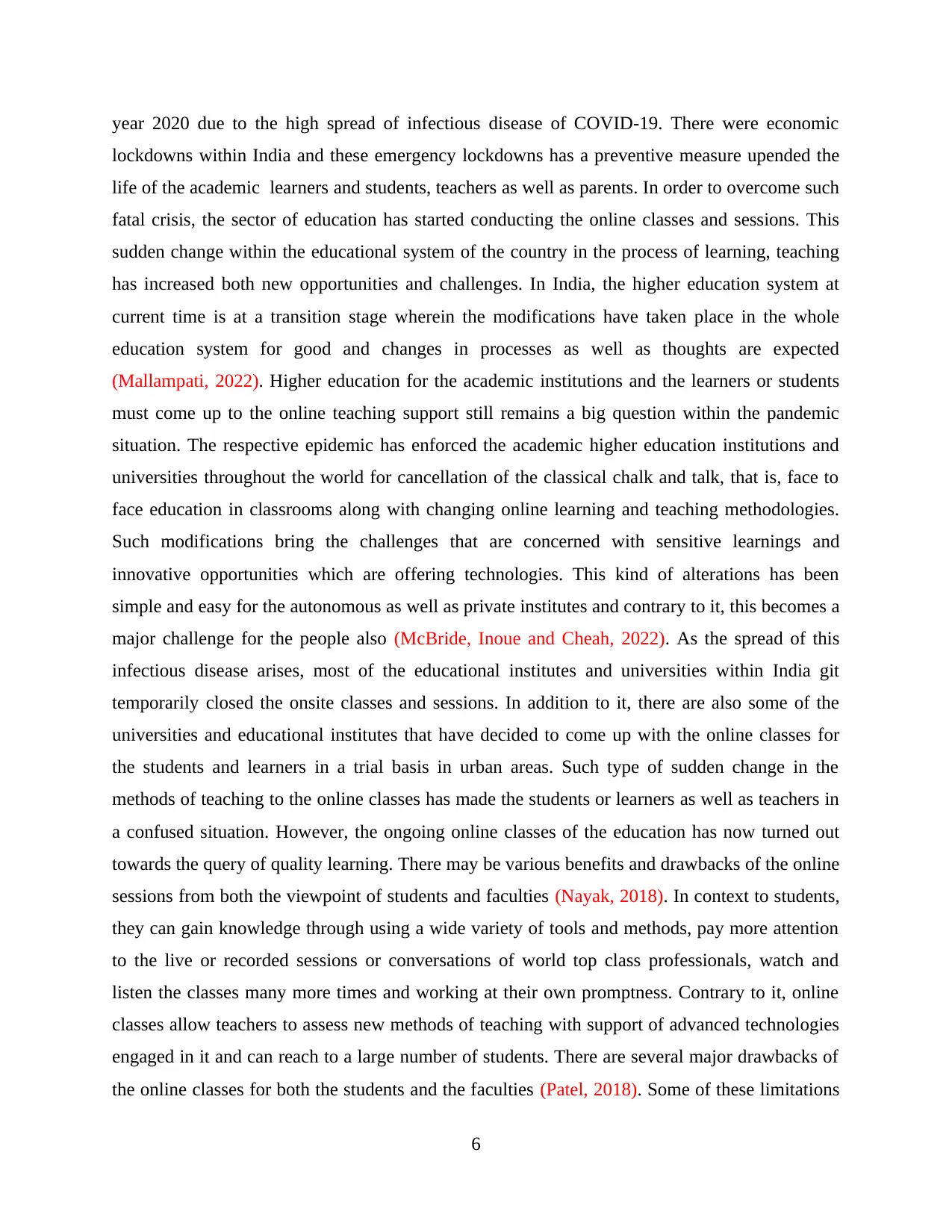
year 2020 due to the high spread of infectious disease of COVID-19. There were economic
lockdowns within India and these emergency lockdowns has a preventive measure upended the
life of the academic learners and students, teachers as well as parents. In order to overcome such
fatal crisis, the sector of education has started conducting the online classes and sessions. This
sudden change within the educational system of the country in the process of learning, teaching
has increased both new opportunities and challenges. In India, the higher education system at
current time is at a transition stage wherein the modifications have taken place in the whole
education system for good and changes in processes as well as thoughts are expected
(Mallampati, 2022). Higher education for the academic institutions and the learners or students
must come up to the online teaching support still remains a big question within the pandemic
situation. The respective epidemic has enforced the academic higher education institutions and
universities throughout the world for cancellation of the classical chalk and talk, that is, face to
face education in classrooms along with changing online learning and teaching methodologies.
Such modifications bring the challenges that are concerned with sensitive learnings and
innovative opportunities which are offering technologies. This kind of alterations has been
simple and easy for the autonomous as well as private institutes and contrary to it, this becomes a
major challenge for the people also (McBride, Inoue and Cheah, 2022). As the spread of this
infectious disease arises, most of the educational institutes and universities within India git
temporarily closed the onsite classes and sessions. In addition to it, there are also some of the
universities and educational institutes that have decided to come up with the online classes for
the students and learners in a trial basis in urban areas. Such type of sudden change in the
methods of teaching to the online classes has made the students or learners as well as teachers in
a confused situation. However, the ongoing online classes of the education has now turned out
towards the query of quality learning. There may be various benefits and drawbacks of the online
sessions from both the viewpoint of students and faculties (Nayak, 2018). In context to students,
they can gain knowledge through using a wide variety of tools and methods, pay more attention
to the live or recorded sessions or conversations of world top class professionals, watch and
listen the classes many more times and working at their own promptness. Contrary to it, online
classes allow teachers to assess new methods of teaching with support of advanced technologies
engaged in it and can reach to a large number of students. There are several major drawbacks of
the online classes for both the students and the faculties (Patel, 2018). Some of these limitations
6
lockdowns within India and these emergency lockdowns has a preventive measure upended the
life of the academic learners and students, teachers as well as parents. In order to overcome such
fatal crisis, the sector of education has started conducting the online classes and sessions. This
sudden change within the educational system of the country in the process of learning, teaching
has increased both new opportunities and challenges. In India, the higher education system at
current time is at a transition stage wherein the modifications have taken place in the whole
education system for good and changes in processes as well as thoughts are expected
(Mallampati, 2022). Higher education for the academic institutions and the learners or students
must come up to the online teaching support still remains a big question within the pandemic
situation. The respective epidemic has enforced the academic higher education institutions and
universities throughout the world for cancellation of the classical chalk and talk, that is, face to
face education in classrooms along with changing online learning and teaching methodologies.
Such modifications bring the challenges that are concerned with sensitive learnings and
innovative opportunities which are offering technologies. This kind of alterations has been
simple and easy for the autonomous as well as private institutes and contrary to it, this becomes a
major challenge for the people also (McBride, Inoue and Cheah, 2022). As the spread of this
infectious disease arises, most of the educational institutes and universities within India git
temporarily closed the onsite classes and sessions. In addition to it, there are also some of the
universities and educational institutes that have decided to come up with the online classes for
the students and learners in a trial basis in urban areas. Such type of sudden change in the
methods of teaching to the online classes has made the students or learners as well as teachers in
a confused situation. However, the ongoing online classes of the education has now turned out
towards the query of quality learning. There may be various benefits and drawbacks of the online
sessions from both the viewpoint of students and faculties (Nayak, 2018). In context to students,
they can gain knowledge through using a wide variety of tools and methods, pay more attention
to the live or recorded sessions or conversations of world top class professionals, watch and
listen the classes many more times and working at their own promptness. Contrary to it, online
classes allow teachers to assess new methods of teaching with support of advanced technologies
engaged in it and can reach to a large number of students. There are several major drawbacks of
the online classes for both the students and the faculties (Patel, 2018). Some of these limitations
6
⊘ This is a preview!⊘
Do you want full access?
Subscribe today to unlock all pages.

Trusted by 1+ million students worldwide
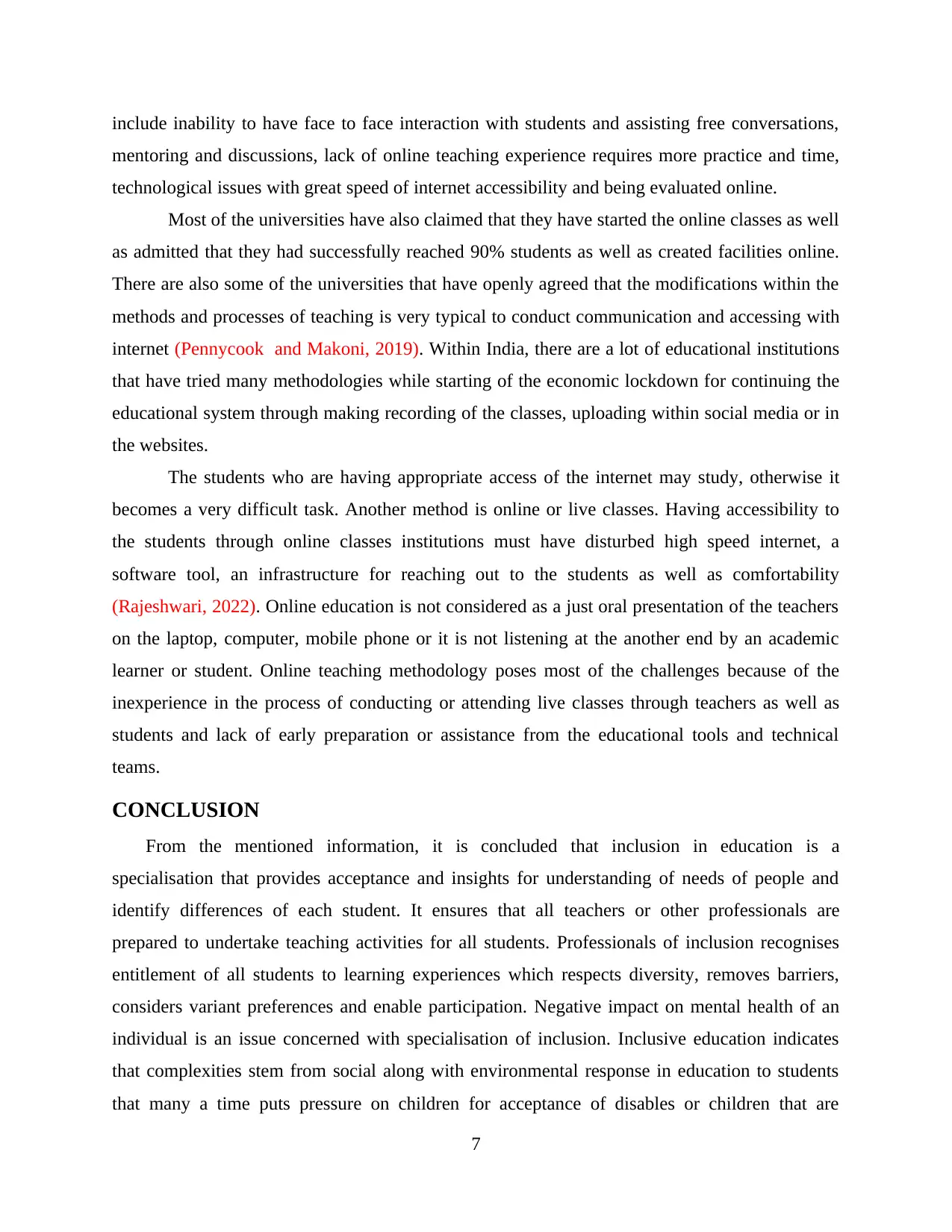
include inability to have face to face interaction with students and assisting free conversations,
mentoring and discussions, lack of online teaching experience requires more practice and time,
technological issues with great speed of internet accessibility and being evaluated online.
Most of the universities have also claimed that they have started the online classes as well
as admitted that they had successfully reached 90% students as well as created facilities online.
There are also some of the universities that have openly agreed that the modifications within the
methods and processes of teaching is very typical to conduct communication and accessing with
internet (Pennycook and Makoni, 2019). Within India, there are a lot of educational institutions
that have tried many methodologies while starting of the economic lockdown for continuing the
educational system through making recording of the classes, uploading within social media or in
the websites.
The students who are having appropriate access of the internet may study, otherwise it
becomes a very difficult task. Another method is online or live classes. Having accessibility to
the students through online classes institutions must have disturbed high speed internet, a
software tool, an infrastructure for reaching out to the students as well as comfortability
(Rajeshwari, 2022). Online education is not considered as a just oral presentation of the teachers
on the laptop, computer, mobile phone or it is not listening at the another end by an academic
learner or student. Online teaching methodology poses most of the challenges because of the
inexperience in the process of conducting or attending live classes through teachers as well as
students and lack of early preparation or assistance from the educational tools and technical
teams.
CONCLUSION
From the mentioned information, it is concluded that inclusion in education is a
specialisation that provides acceptance and insights for understanding of needs of people and
identify differences of each student. It ensures that all teachers or other professionals are
prepared to undertake teaching activities for all students. Professionals of inclusion recognises
entitlement of all students to learning experiences which respects diversity, removes barriers,
considers variant preferences and enable participation. Negative impact on mental health of an
individual is an issue concerned with specialisation of inclusion. Inclusive education indicates
that complexities stem from social along with environmental response in education to students
that many a time puts pressure on children for acceptance of disables or children that are
7
mentoring and discussions, lack of online teaching experience requires more practice and time,
technological issues with great speed of internet accessibility and being evaluated online.
Most of the universities have also claimed that they have started the online classes as well
as admitted that they had successfully reached 90% students as well as created facilities online.
There are also some of the universities that have openly agreed that the modifications within the
methods and processes of teaching is very typical to conduct communication and accessing with
internet (Pennycook and Makoni, 2019). Within India, there are a lot of educational institutions
that have tried many methodologies while starting of the economic lockdown for continuing the
educational system through making recording of the classes, uploading within social media or in
the websites.
The students who are having appropriate access of the internet may study, otherwise it
becomes a very difficult task. Another method is online or live classes. Having accessibility to
the students through online classes institutions must have disturbed high speed internet, a
software tool, an infrastructure for reaching out to the students as well as comfortability
(Rajeshwari, 2022). Online education is not considered as a just oral presentation of the teachers
on the laptop, computer, mobile phone or it is not listening at the another end by an academic
learner or student. Online teaching methodology poses most of the challenges because of the
inexperience in the process of conducting or attending live classes through teachers as well as
students and lack of early preparation or assistance from the educational tools and technical
teams.
CONCLUSION
From the mentioned information, it is concluded that inclusion in education is a
specialisation that provides acceptance and insights for understanding of needs of people and
identify differences of each student. It ensures that all teachers or other professionals are
prepared to undertake teaching activities for all students. Professionals of inclusion recognises
entitlement of all students to learning experiences which respects diversity, removes barriers,
considers variant preferences and enable participation. Negative impact on mental health of an
individual is an issue concerned with specialisation of inclusion. Inclusive education indicates
that complexities stem from social along with environmental response in education to students
that many a time puts pressure on children for acceptance of disables or children that are
7
Paraphrase This Document
Need a fresh take? Get an instant paraphrase of this document with our AI Paraphraser
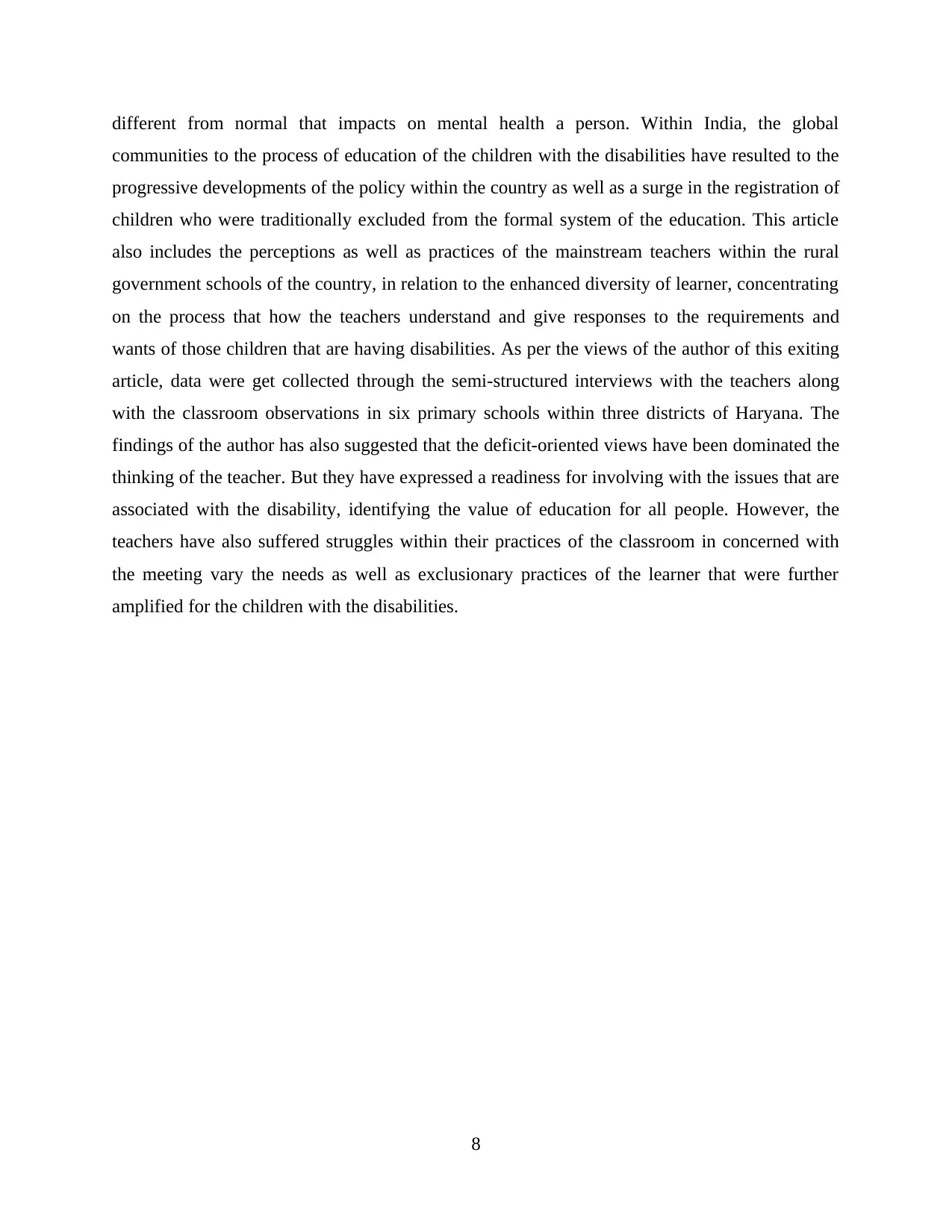
different from normal that impacts on mental health a person. Within India, the global
communities to the process of education of the children with the disabilities have resulted to the
progressive developments of the policy within the country as well as a surge in the registration of
children who were traditionally excluded from the formal system of the education. This article
also includes the perceptions as well as practices of the mainstream teachers within the rural
government schools of the country, in relation to the enhanced diversity of learner, concentrating
on the process that how the teachers understand and give responses to the requirements and
wants of those children that are having disabilities. As per the views of the author of this exiting
article, data were get collected through the semi-structured interviews with the teachers along
with the classroom observations in six primary schools within three districts of Haryana. The
findings of the author has also suggested that the deficit-oriented views have been dominated the
thinking of the teacher. But they have expressed a readiness for involving with the issues that are
associated with the disability, identifying the value of education for all people. However, the
teachers have also suffered struggles within their practices of the classroom in concerned with
the meeting vary the needs as well as exclusionary practices of the learner that were further
amplified for the children with the disabilities.
8
communities to the process of education of the children with the disabilities have resulted to the
progressive developments of the policy within the country as well as a surge in the registration of
children who were traditionally excluded from the formal system of the education. This article
also includes the perceptions as well as practices of the mainstream teachers within the rural
government schools of the country, in relation to the enhanced diversity of learner, concentrating
on the process that how the teachers understand and give responses to the requirements and
wants of those children that are having disabilities. As per the views of the author of this exiting
article, data were get collected through the semi-structured interviews with the teachers along
with the classroom observations in six primary schools within three districts of Haryana. The
findings of the author has also suggested that the deficit-oriented views have been dominated the
thinking of the teacher. But they have expressed a readiness for involving with the issues that are
associated with the disability, identifying the value of education for all people. However, the
teachers have also suffered struggles within their practices of the classroom in concerned with
the meeting vary the needs as well as exclusionary practices of the learner that were further
amplified for the children with the disabilities.
8
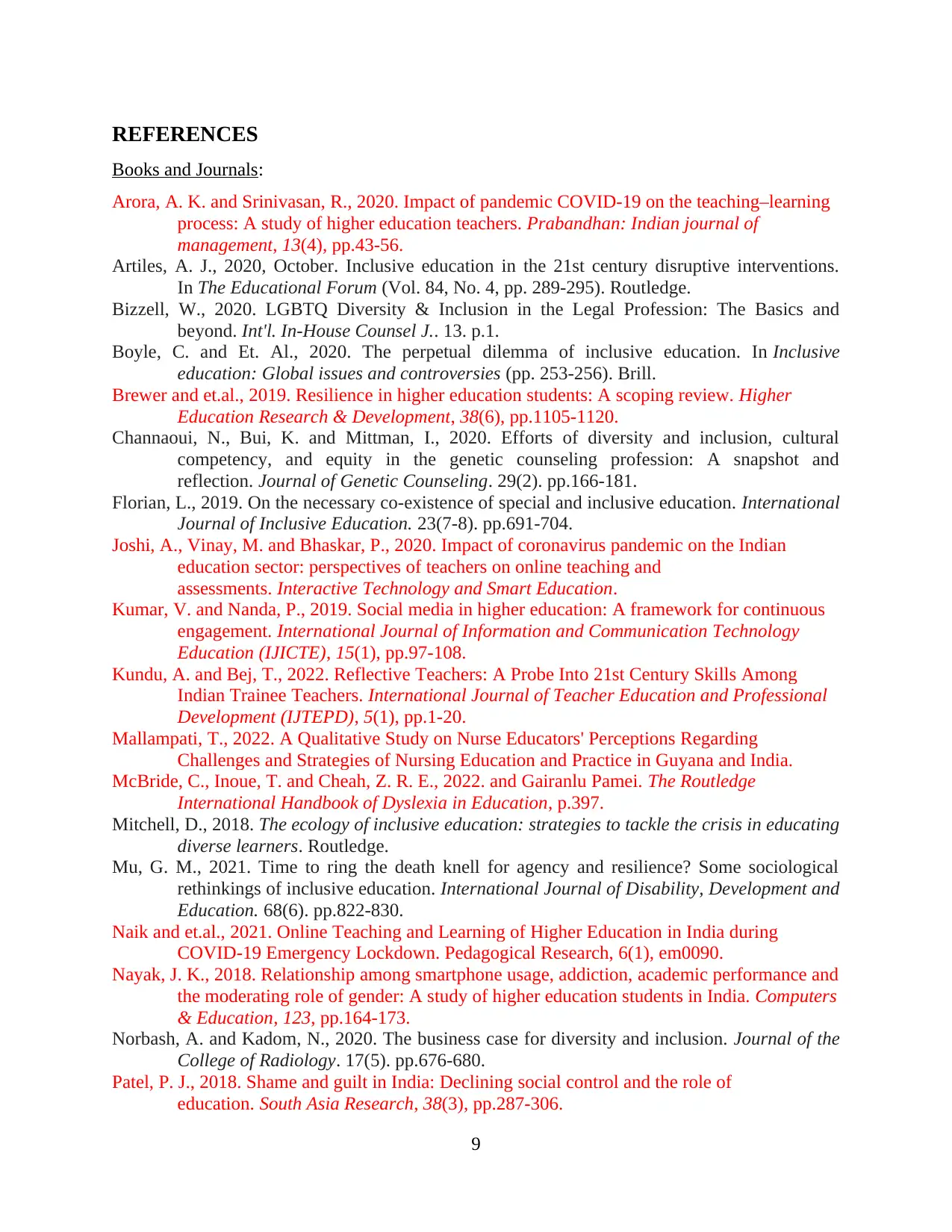
REFERENCES
Books and Journals:
Arora, A. K. and Srinivasan, R., 2020. Impact of pandemic COVID-19 on the teaching–learning
process: A study of higher education teachers. Prabandhan: Indian journal of
management, 13(4), pp.43-56.
Artiles, A. J., 2020, October. Inclusive education in the 21st century disruptive interventions.
In The Educational Forum (Vol. 84, No. 4, pp. 289-295). Routledge.
Bizzell, W., 2020. LGBTQ Diversity & Inclusion in the Legal Profession: The Basics and
beyond. Int'l. In-House Counsel J.. 13. p.1.
Boyle, C. and Et. Al., 2020. The perpetual dilemma of inclusive education. In Inclusive
education: Global issues and controversies (pp. 253-256). Brill.
Brewer and et.al., 2019. Resilience in higher education students: A scoping review. Higher
Education Research & Development, 38(6), pp.1105-1120.
Channaoui, N., Bui, K. and Mittman, I., 2020. Efforts of diversity and inclusion, cultural
competency, and equity in the genetic counseling profession: A snapshot and
reflection. Journal of Genetic Counseling. 29(2). pp.166-181.
Florian, L., 2019. On the necessary co-existence of special and inclusive education. International
Journal of Inclusive Education. 23(7-8). pp.691-704.
Joshi, A., Vinay, M. and Bhaskar, P., 2020. Impact of coronavirus pandemic on the Indian
education sector: perspectives of teachers on online teaching and
assessments. Interactive Technology and Smart Education.
Kumar, V. and Nanda, P., 2019. Social media in higher education: A framework for continuous
engagement. International Journal of Information and Communication Technology
Education (IJICTE), 15(1), pp.97-108.
Kundu, A. and Bej, T., 2022. Reflective Teachers: A Probe Into 21st Century Skills Among
Indian Trainee Teachers. International Journal of Teacher Education and Professional
Development (IJTEPD), 5(1), pp.1-20.
Mallampati, T., 2022. A Qualitative Study on Nurse Educators' Perceptions Regarding
Challenges and Strategies of Nursing Education and Practice in Guyana and India.
McBride, C., Inoue, T. and Cheah, Z. R. E., 2022. and Gairanlu Pamei. The Routledge
International Handbook of Dyslexia in Education, p.397.
Mitchell, D., 2018. The ecology of inclusive education: strategies to tackle the crisis in educating
diverse learners. Routledge.
Mu, G. M., 2021. Time to ring the death knell for agency and resilience? Some sociological
rethinkings of inclusive education. International Journal of Disability, Development and
Education. 68(6). pp.822-830.
Naik and et.al., 2021. Online Teaching and Learning of Higher Education in India during
COVID-19 Emergency Lockdown. Pedagogical Research, 6(1), em0090.
Nayak, J. K., 2018. Relationship among smartphone usage, addiction, academic performance and
the moderating role of gender: A study of higher education students in India. Computers
& Education, 123, pp.164-173.
Norbash, A. and Kadom, N., 2020. The business case for diversity and inclusion. Journal of the
College of Radiology. 17(5). pp.676-680.
Patel, P. J., 2018. Shame and guilt in India: Declining social control and the role of
education. South Asia Research, 38(3), pp.287-306.
9
Books and Journals:
Arora, A. K. and Srinivasan, R., 2020. Impact of pandemic COVID-19 on the teaching–learning
process: A study of higher education teachers. Prabandhan: Indian journal of
management, 13(4), pp.43-56.
Artiles, A. J., 2020, October. Inclusive education in the 21st century disruptive interventions.
In The Educational Forum (Vol. 84, No. 4, pp. 289-295). Routledge.
Bizzell, W., 2020. LGBTQ Diversity & Inclusion in the Legal Profession: The Basics and
beyond. Int'l. In-House Counsel J.. 13. p.1.
Boyle, C. and Et. Al., 2020. The perpetual dilemma of inclusive education. In Inclusive
education: Global issues and controversies (pp. 253-256). Brill.
Brewer and et.al., 2019. Resilience in higher education students: A scoping review. Higher
Education Research & Development, 38(6), pp.1105-1120.
Channaoui, N., Bui, K. and Mittman, I., 2020. Efforts of diversity and inclusion, cultural
competency, and equity in the genetic counseling profession: A snapshot and
reflection. Journal of Genetic Counseling. 29(2). pp.166-181.
Florian, L., 2019. On the necessary co-existence of special and inclusive education. International
Journal of Inclusive Education. 23(7-8). pp.691-704.
Joshi, A., Vinay, M. and Bhaskar, P., 2020. Impact of coronavirus pandemic on the Indian
education sector: perspectives of teachers on online teaching and
assessments. Interactive Technology and Smart Education.
Kumar, V. and Nanda, P., 2019. Social media in higher education: A framework for continuous
engagement. International Journal of Information and Communication Technology
Education (IJICTE), 15(1), pp.97-108.
Kundu, A. and Bej, T., 2022. Reflective Teachers: A Probe Into 21st Century Skills Among
Indian Trainee Teachers. International Journal of Teacher Education and Professional
Development (IJTEPD), 5(1), pp.1-20.
Mallampati, T., 2022. A Qualitative Study on Nurse Educators' Perceptions Regarding
Challenges and Strategies of Nursing Education and Practice in Guyana and India.
McBride, C., Inoue, T. and Cheah, Z. R. E., 2022. and Gairanlu Pamei. The Routledge
International Handbook of Dyslexia in Education, p.397.
Mitchell, D., 2018. The ecology of inclusive education: strategies to tackle the crisis in educating
diverse learners. Routledge.
Mu, G. M., 2021. Time to ring the death knell for agency and resilience? Some sociological
rethinkings of inclusive education. International Journal of Disability, Development and
Education. 68(6). pp.822-830.
Naik and et.al., 2021. Online Teaching and Learning of Higher Education in India during
COVID-19 Emergency Lockdown. Pedagogical Research, 6(1), em0090.
Nayak, J. K., 2018. Relationship among smartphone usage, addiction, academic performance and
the moderating role of gender: A study of higher education students in India. Computers
& Education, 123, pp.164-173.
Norbash, A. and Kadom, N., 2020. The business case for diversity and inclusion. Journal of the
College of Radiology. 17(5). pp.676-680.
Patel, P. J., 2018. Shame and guilt in India: Declining social control and the role of
education. South Asia Research, 38(3), pp.287-306.
9
⊘ This is a preview!⊘
Do you want full access?
Subscribe today to unlock all pages.

Trusted by 1+ million students worldwide
1 out of 13
Related Documents
Your All-in-One AI-Powered Toolkit for Academic Success.
+13062052269
info@desklib.com
Available 24*7 on WhatsApp / Email
![[object Object]](/_next/static/media/star-bottom.7253800d.svg)
Unlock your academic potential
Copyright © 2020–2025 A2Z Services. All Rights Reserved. Developed and managed by ZUCOL.





